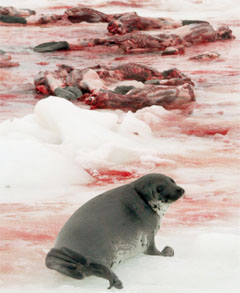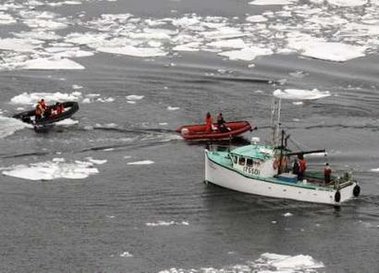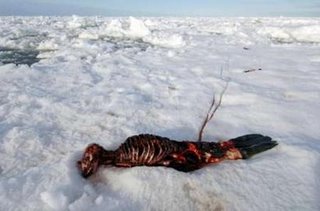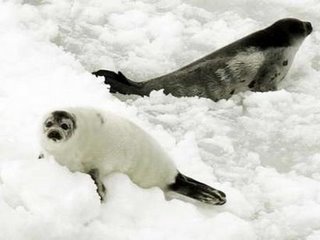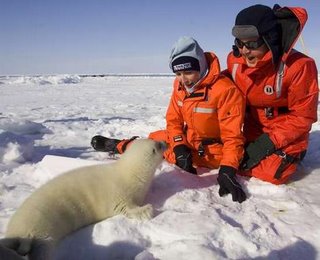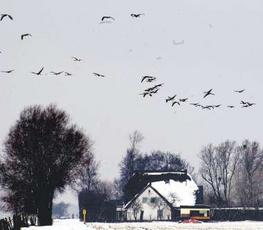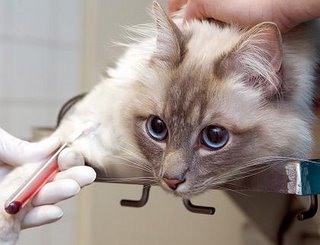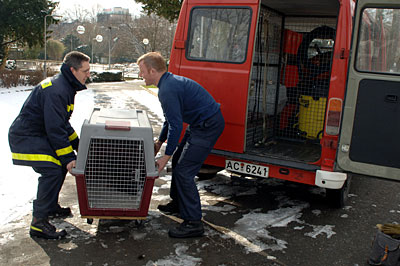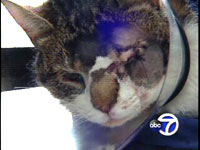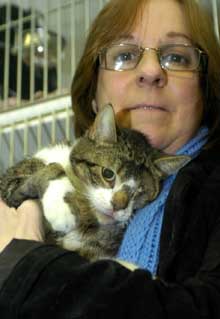 |
| A Sea Otter |
"So the cat through the ages has been more cruelly and persistently mistreated than any other beast."
-- Carl Van Vechten, The Tiger in the House
Vivisectors at so-called institutions of higher learning torture and mutilate them with impunity for profit and fame all the while swearing allegiance to the advancement of science. In China, Korea, and elsewhere millions are slaughtered for their meat, fur, and medicinal value.
(See Cat Defender posts of February 8, 2006 and December 15, 2005, respectively entitled "Stray Cats Rounded Up in Shanghai, Butchered, and Sold as Mutton in Restaurants and on the Street," and "Heather Mills Asks EU to Ban Sale of Cat and Dog Fur; Paul McCartney Calls for Boycott of Chinese Goods and Olympics.")
Circuses and zoos exploit them, motorists run them down for sport, and kids harass and torture them. During the Middle Ages the Catholic Church exterminated them because they were fraudulently alleged to have been the familiars of witches. As the result of this madness, nearly one-third of the European population was wiped out by the bubonic plague because the rat population, widely believed to have been responsible for spreading the deadly disease, went unchecked.
In more recent times, the American Bird Conservancy (ABC), the National Audubon Society, PETA, National Wildlife, and
National Geographic have all called for the roundup and extermination of feral cats because they allege that they are having a detrimental impact upon birds.
When the Israeli colonialists abandoned twenty-one colonies in Gaza and four more in the West Bank last August they left behind thousands of cats to die of hunger, thirst, and predation in the desert heat. Hundreds more have been poisoned in Israel during the past six years because they were suspected of carrying the rabies virus. Authorities in both Australia and New Zealand have likewise launched feline extermination campaigns on the pretext of protecting wildlife.
(See Cat Defender post of November 7, 2005 entitled "Israeli Colonialists in Gaza and the West Bank Leave Behind Thousands of Cats to Die of Thirst, Hunger, and Predation.")
Now, Professor Patricia Conrad of the University of California at Davis has joined the ailurophobes by calling for all feral cats to be rounded up and exterminated because she alleges that a parasite carried by them is responsible for a decline in the population of sea otters living along the California coast. While the scientific evidence for Conrad's assertion is far from convincing, she has already found a powerful ally in the form of the BBC.
In one of the worst examples of scurrilous, one-sided journalism ever, Paul Rincon of the BBC reprinted Conrad's anti-cat screed practically word-for-word on February 19th without questioning either the veracity of her research or the validity of her conclusions.
(See "Cat Parasite 'Is Killing Otters.'") It is truly amazing how the corporate media, the police-military establishment, crooked politicians, and hack scholars living on welfare all stick together like congealed feces.
Although Conrad and her cronies at UC-Davis have been maligning cats with impunity for the past ten years, the latest brouhaha developed as the result of a paper that she delivered at the annual meeting of the American Association for the Advancement of Science (AAAS) in St. Louis, February 16-20. Simply put, Conrad argues that cat feces containing the parasite toxoplasma gondii is being carried into the Pacific Ocean by either tributary streams or through sewerage systems where it is then ingested by otters in either the water or the mussels, clams, and oysters that they consume. Once ingested, the parasite lays waste to the otters' brains causing death by either toxoplasma encephalitis or, because of their weakened condition, predation by sharks.
 |
| Patricia Conrad |
Toxoplasma gondii is the same parasite that pregnant women are urged to take precautions against, especially when changing litter boxes. It can also create problems for organ transplant recipients and individuals with compromised immune systems (
e.g., HIV-AIDS). In extreme cases it has been blamed for automobile accidents, schizophrenia, and risk-taking behavior. Generally, however, it is not a problem for most humans as long as they avoid raw and undercooked meat and rinse off vegetables before consuming them.
To give the devil her due, necropsies performed by Conrad and her cronies have found toxoplasma gondii in hundreds of sea otters
(Enhydra lutris). Since, according to her and others, only cats shed this parasite they are accordingly the ones responsible for killing the otters. However, an article by A.J.S. Rayl appearing in the February 19, 2001 edition of
The Scientist and entitled "Researchers Focus on Sea Otter Deaths," also blames Sarcocystis neurona, a parasite carried by possums, for killing otters.
As any fool knows, the oceans are dying a slow death. When man is not killing off the fish and mammals in order to line his pockets, he is using their habitat as the world's largest garbage disposal site.
Sewage, farm and industrial waste, oil, deadly chemicals such as PCBs, military waste including nuclear fallout, and garbage from boats and airplanes are only a few of the destructive pollutants that are routinely dumped into the seas. Due to the depletion of the ozone layer, whales and possibly other marine mammals are contracting deadly skin cancers and off the east coast of Africa coral reefs are dying because motorboat propellers are destroying the sea grass which filters out impurities in the water.
Instead of focusing exclusively upon toxoplasma gondii, Conrad should take a long hard look at global warming. Ken Caldeira of Carnegie Institution told a gathering of the American Geophysical Union in Hawaii last week that carbon dioxide emissions are leading to an increase in acid levels in the oceans which in turn are not only destroying coral reefs and plankton but also the calcium carbonate shells of the crabs, oysters, and mussels that sea otters and other marine mammals eat. Unless this trend is reversed, shellfish are going to die out.
Caldeira's research is buttressed by the findings of Jim Orr of the Laboratory for Science of the Climate and Environment in Paris who recently predicted in an article for
Nature that by 2050 both the Southern Ocean and sub-Arctic regions of the Pacific will be too acidic in order to support the continued existence of shellfish. If this occurs, it will be cataclysmic for the salmon, mackerel, herring, cod, and baleen whales who feed upon sea butterflies (pteropods).
(See The Sunday Times of London, February 26, 2006, "Acid Seas Kill Off Coral Reefs.")
In 2002, the United Kingdom Environmental Agency reported that sewage containing female urine laced with residual estrogen from birth control pills was responsible for altering the sex of male fish in the Thames. On January 22nd, London's
Independent reported that oxybenzone, a chemical used in sunscreens, was responsible for feminizing male horneyhead turbots and English soles who feed near sewage pipes which empty into the Pacific at Huntington Beach.
(See "If Your Suntan Oil (sic) Can Change the Sex of Fish, What Can It Do to You?")
The Swiss have likewise found gender-bending chemicals from sun creams and oils in fish caught in their streams. Researchers theorize that oxybenzone and other chemicals used in sunscreens are washed off in the shower and pass unaltered through sewerage systems before they settle into the seabed where they are consumed by bottom-feeding fish.
Based upon the warped logic which Conrad and her gang of cat-haters have put forward, users of both birth control pills and sunscreen should be exterminated. Of course, she does not have the temerity to make such a public utterance because if she did she would undoubtedly not only be kicked out of academia but locked up in a nuthouse as well.
Unlike people, cats do not have money,
shysters, and press agents and are thus unable to defend themselves against monsters like Conrad. Thanks to the BBC and other news outlets, cats almost always receive a bad press and this makes them easy targets for groups and individuals wanting to annihilate them.
 |
| Sewage Pipes |
Considering the volume of deadly pollutants dumped into the oceans it is difficult to believe that cat feces alone is to blame for the high mortality rate among otters and Conrad's research should therefore not be taken as gospel. Even if she is correct, her decision to join the ailurophobes at the ABC in calling for all cats to be confined indoors is not merely ludicrous but barbaric as well.
She and her followers are far too dishonest and cowardly to admit it but this would mean that seventy-eight million feral cats in the United States would have to be rounded up and exterminated. The reason that there are so many of them in the first place is due to the fact that there are insufficient homes for them now.
Almost one-hundred
per cent of all feral cats trapped by animal control personnel and other groups are immediately exterminated. Some of them are killed on the spot and hardly any of them who are lucky enough to make it to shelters alive are ever put up for adoption. Shelter workers are too cheap to house and feed them and too lazy to socialize them for adoption.
Moreover, they get a kick out of killing defenseless and innocent animals. Phony-baloney PETA admits to having a kill rate of eighty-six
per cent at its Norfolk, Virginia shelter and even Alley Cat Allies returns to the wild only about forty
per cent of the cats that it traps; the other sixty
per cent are exterminated. As it is, an estimated ten million cats and seven million dogs are exterminated at shelters every year in the United States.
Once dispatched, they are unceremoniously dumped in landfills where their sodium pentobarbital-laced corpses kill again by claiming the lives of eagles, coyotes, and other scavengers. There can be little doubt that some of these deadly barbiturates also make their way into the oceans but neither Conrad nor the BBC have anything to say about this subject.
Since all cats, feral and domestic, cover up their feces, the presence of toxoplasma gondii oocysts in the Pacific Ocean is in itself an indictment of both officials and residents of California for poor land and water management. Too much development and, in particular, the paving over and extensive farming of the land, means that rainwater and runoff from farms and developments goes directly into storm drains and then into rivers and out into the ocean without being treated.
Rather than killing cats, development should be curbed and freshwater runoff purified before it is allowed to enter the oceans. Municipal sewerage systems likewise need to start treating their sewage for toxoplasma gondii because a number of cat litter manufacturers are marketing flushable litter.
The plight of otters is truly regrettable. Hunted almost to extinction during the nineteenth century for their valuable pelts, they have just as much of a right to live as any other animal, man included. The continued existence of two-thousand otters should not, however, come at the expense of seventy-eight million feral cats, especially when humane solutions are readily available.
Sadly, Conrad and her supporters do not have any genuine interest in protecting either the oceans or in preserving marine mammals and fish. They only want to kill cats! If she were serious, she would go after capitalists and consumers alike but she is unwilling to do that because she makes her living off of handouts from both groups.
Closer to home, it would be interesting to know what Conrad has to say about the three laboratories that her own University of California operates (Lawrence Berkeley, Lawrence Livermore, and Los Alamos) and which have been heavily involved in the development of nuclear weapons since the days of the Manhattan Project. How many people, animals, and sections of Mother Earth has her own employer, directely or indirectly, obliterated over the past sixty-five years? Like bird advocates, she is every bit as greedy, dishonest, and corrupt as the capitalists and consumers that she represents.
As for cats, one can only wonder what they will be blamed for next. What about the common cold? Or, say, constipation, the weather, wars, poverty, and budget deficits? Just as the number of ailurophobes is almost infinite so, too, are their lies. Most alarming of all, neither Conrad nor the BBC is willing to acknowledge either the immorality of killing cats or the thousands of years of invaluable service that they have rendered mankind through their companionship and rodent control.
As celebrated author Lilian Jackson Braun once wrote, "These intelligent, peace-loving, four-footed friends -- who are without prejudice, without hate, without greed -- may someday teach us something."
Malheursement, no one can reason with a cat-hater.
Photos: U.S. Fish and Wildlife Service (sea otter), University of California at Davis (Conrad), and BBC (sewage pipes).



